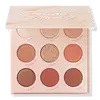What's inside
What's inside
 Key Ingredients
Key Ingredients

 Benefits
Benefits

 Concerns
Concerns

 Ingredients Side-by-side
Ingredients Side-by-side

Zinc Stearate
Cosmetic ColorantSynthetic Fluorphlogopite
Polymethylsilsesquioxane
Magnesium Stearate
Cosmetic ColorantBoron Nitride
AbsorbentDimethicone
EmollientCaprylic/Capric Triglyceride
MaskingPhenoxyethanol
PreservativeCaprylyl Glycol
EmollientEthylhexylglycerin
Skin ConditioningHexylene Glycol
EmulsifyingDimethiconol
EmollientIron Oxides
Mica
Cosmetic ColorantCI 77891
Cosmetic ColorantEthylhexyl Isononanoate
EmollientTrimethylsiloxysilicate
EmollientAlumina
AbrasiveDimethicone Crosspolymer
Emulsion StabilisingIsopropyl Myristate
EmollientCetyl Dimethicone
EmollientStearalkonium Hectorite
Gel FormingTin Oxide
AbrasivePropylene Carbonate
SolventCI 75470
Cosmetic ColorantCI 77491
Cosmetic ColorantTalc
AbrasiveLauroyl Lysine
Skin ConditioningSilica
AbrasiveCI 16035
Cosmetic ColorantCI 19140
Cosmetic ColorantCalcium Sodium Borosilicate
Magnesium Myristate
Aluminum Starch Octenylsuccinate
AbsorbentCI 42090
Cosmetic ColorantZinc Stearate, Synthetic Fluorphlogopite, Polymethylsilsesquioxane, Magnesium Stearate, Boron Nitride, Dimethicone, Caprylic/Capric Triglyceride, Phenoxyethanol, Caprylyl Glycol, Ethylhexylglycerin, Hexylene Glycol, Dimethiconol, Iron Oxides, Mica, CI 77891, Ethylhexyl Isononanoate, Trimethylsiloxysilicate, Alumina, Dimethicone Crosspolymer, Isopropyl Myristate, Cetyl Dimethicone, Stearalkonium Hectorite, Tin Oxide, Propylene Carbonate, CI 75470, CI 77491, Talc, Lauroyl Lysine, Silica, CI 16035, CI 19140, Calcium Sodium Borosilicate, Magnesium Myristate, Aluminum Starch Octenylsuccinate, CI 42090
Diisostearyl Malate
EmollientDiphenylsiloxy Phenyl Trimethicone
Skin ConditioningWater
Skin ConditioningDiphenyl Dimethicone
EmollientBis-Diglyceryl Polyacyladipate-2
EmollientHydrogenated Polyisobutene
EmollientPolyglycerin-3
HumectantPolysorbate 60
EmulsifyingCetyl PEG/PPG-10/1 Dimethicone
EmulsifyingSorbitan Isostearate
EmulsifyingButylene Glycol
Humectant1,2-Hexanediol
Skin ConditioningDimethicone
EmollientPentylene Glycol
Skin ConditioningHydroxyethyl Acrylate/Sodium Acryloyldimethyl Taurate Copolymer
Emulsion StabilisingCeteareth-20
CleansingSqualene
EmollientXylitol
HumectantCI 77491
Cosmetic ColorantParfum
MaskingCI 15985
Cosmetic ColorantAcid Red 33
Ethylhexylglycerin
Skin ConditioningCI 19140
Cosmetic ColorantAmmonium Polyacrylate
StabilisingCI 42090
Cosmetic ColorantPhenoxyethanol
PreservativeTocopherol
AntioxidantDiisostearyl Malate, Diphenylsiloxy Phenyl Trimethicone, Water, Diphenyl Dimethicone, Bis-Diglyceryl Polyacyladipate-2, Hydrogenated Polyisobutene, Polyglycerin-3, Polysorbate 60, Cetyl PEG/PPG-10/1 Dimethicone, Sorbitan Isostearate, Butylene Glycol, 1,2-Hexanediol, Dimethicone, Pentylene Glycol, Hydroxyethyl Acrylate/Sodium Acryloyldimethyl Taurate Copolymer, Ceteareth-20, Squalene, Xylitol, CI 77491, Parfum, CI 15985, Acid Red 33, Ethylhexylglycerin, CI 19140, Ammonium Polyacrylate, CI 42090, Phenoxyethanol, Tocopherol
Ingredients Explained
These ingredients are found in both products.
Ingredients higher up in an ingredient list are typically present in a larger amount.
CI 19140 is also known as Tartrazine. Tartrazine is a synthetic dye used in cosmetics, foods, and medicine to add a yellow color.
Tartrazine is created from petroleum and is water-soluble.
Some people may experience allergies from this dye, especially asthmatics and those with an aspirin intolerance.
Learn more about CI 19140Ci 42090 is a synthetic dye created from petroleum. It is used to give a bright blue color to cosmetics, medicine, and food.
Ci 77491 is also hydrated iron III oxide. It's sole purpose is to give a red/pink hue to products.
Iron III oxides are classified as inorganic chemicals for coloring.
Synthetically created Ci 77491 is considered safer than those naturally found. This is because the synthetically created version may contain less impurities. Iron oxides are generally non-toxic and non-allergenic.
Learn more about CI 77491Dimethicone is a type of synthetic silicone created from natural materials such as quartz.
What it does:
Dimethicone comes in different viscosities:
Depending on the viscosity, dimethicone has different properties.
Ingredients lists don't always show which type is used, so we recommend reaching out to the brand if you have questions about the viscosity.
This ingredient is unlikely to cause irritation because it does not get absorbed into skin. However, people with silicone allergies should be careful about using this ingredient.
Note: Dimethicone may contribute to pilling. This is because it is not oil or water soluble, so pilling may occur when layered with products. When mixed with heavy oils in a formula, the outcome is also quite greasy.
Learn more about DimethiconeEthylhexylglycerin (we can't pronounce this either) is commonly used as a preservative and skin softener. It is derived from glyceryl.
You might see Ethylhexylglycerin often paired with other preservatives such as phenoxyethanol. Ethylhexylglycerin has been found to increase the effectiveness of these other preservatives.
Phenoxyethanol is a preservative that has germicide, antimicrobial, and aromatic properties. Studies show that phenoxyethanol can prevent microbial growth. By itself, it has a scent that is similar to that of a rose.
It's often used in formulations along with Caprylyl Glycol to preserve the shelf life of products.